Astaxanthin Market Size
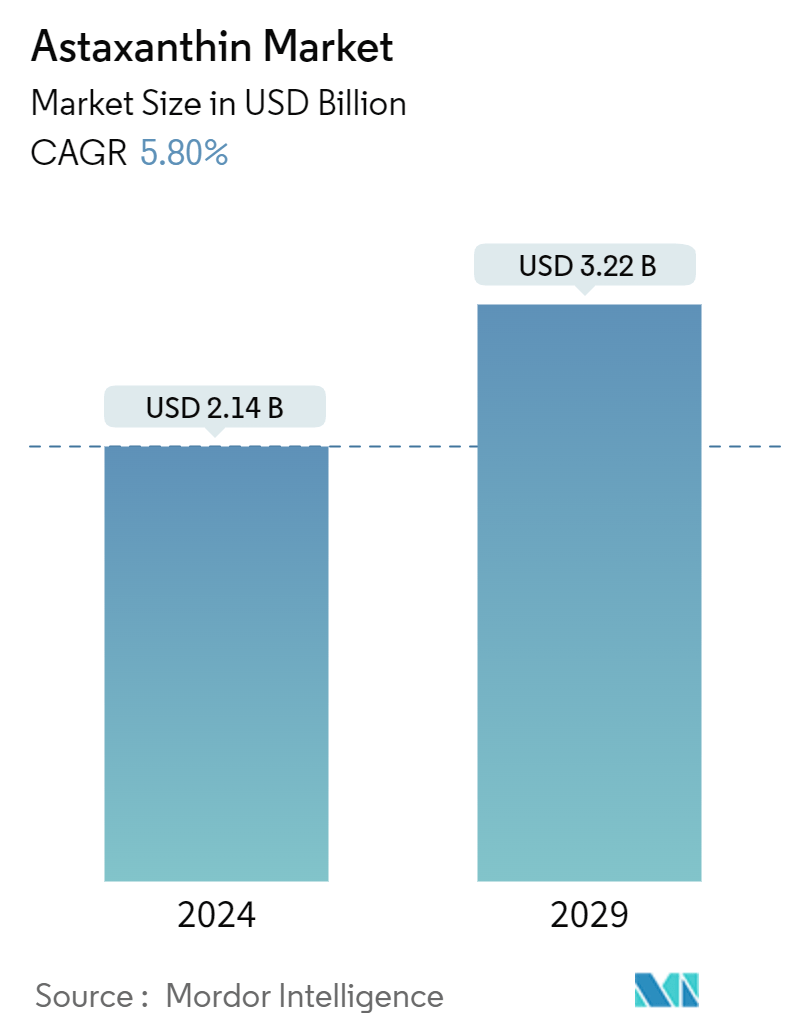
| Study Period | 2019 - 2029 |
| Market Size (2024) | USD 2.14 Billion |
| Market Size (2029) | USD 3.22 Billion |
| CAGR (2024 - 2029) | 5.80 % |
| Fastest Growing Market | Asia-Pacific |
| Largest Market | North America |
Major Players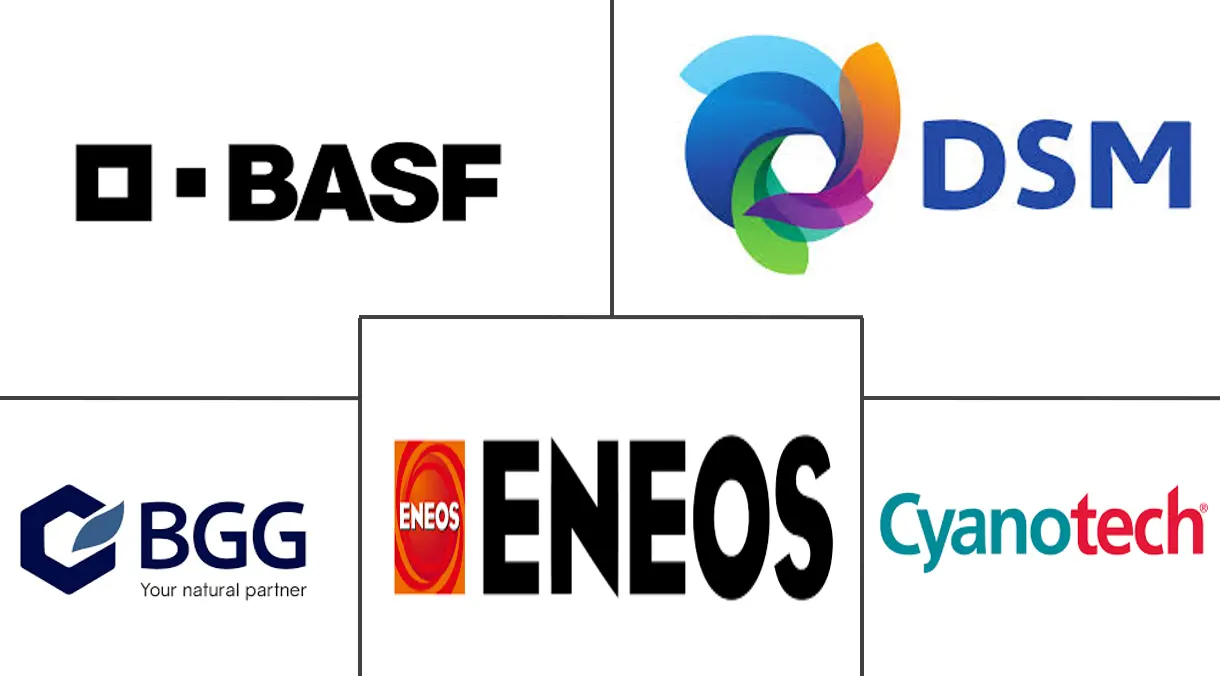
*Disclaimer: Major Players sorted in no particular order |
Need a report that reflects how COVID-19 has impacted this market and its growth?
Astaxanthin Market Analysis
The Astaxanthin Market size is estimated at USD 2.14 billion in 2024, and is expected to reach USD 3.22 billion by 2029, growing at a CAGR of 5.80% during the forecast period (2024-2029).
A growing number of health-conscious individuals are more inclined toward natural food coloring agents with lesser adverse effects than other chemical products, which is an important driver for market growth. The demand for astaxanthin is expected to increase due to its multiple applications in the pharmaceutical, nutraceutical, and feed industries, among others. Also, the unique color and properties associated with astaxanthin have led to its increased use in commercial aquaculture, food coloring, and other applications.
Moreover, the increasing adoption of nutrition-rich products is driving the nutraceuticals industry at a significant rate. Hence, the demand for astaxanthin-based nutritional products is increasing worldwide. The increasing adoption of novel technologies to boost the production of astaxanthin is anticipated to propel growth over the forecast period. For instance, in 2022, ALGAMO produced photo-bioreactors and micro-modules to create astaxanthin while minimizing water waste and saving electricity.
Additionally, ongoing scientific research continues to uncover new benefits and applications for astaxanthin, driving innovation and expanding its use in various industries. Such initiatives help validate its efficacy and attract more consumers.
Astaxanthin Market Trends
Growing Demand for Natural Astaxanthin Among Consumers Driving the Market
The demand for natural astaxanthin has registered significant growth in recent years, which was particularly driven by its expanding application in the food industry. Since astaxanthin is a powerful antioxidant and natural pigment, it is being increasingly utilized as a healthier alternative to synthetic food colorings in various food and beverage products. This shift has been in response to growing consumer awareness and preferences for natural ingredients, which promote clean labeling and perceived health benefits. Additionally, astaxanthin is being increasingly used to provide health benefits, including anti-inflammatory effects, improved immunity, and prevention of cerebrovascular and cardiovascular diseases, among others.
Further, several studies have revealed that astaxanthin can play an important role in preventing photoaging, improving sleep, minimizing obesity, protecting the vocal cord, combating depression, and increasing sperm motility. Due to a growing preference for natural and sustainable products, consumers are favoring natural astaxanthin over synthetic alternatives. Natural astaxanthin is typically derived from microalgae, which is considered more environmentally sustainable than synthetic production methods. In addition, the cosmetic and beauty industry is increasingly incorporating astaxanthin into skincare products due to its ability to protect the skin from UV damage, improve skin elasticity, and reduce wrinkles.
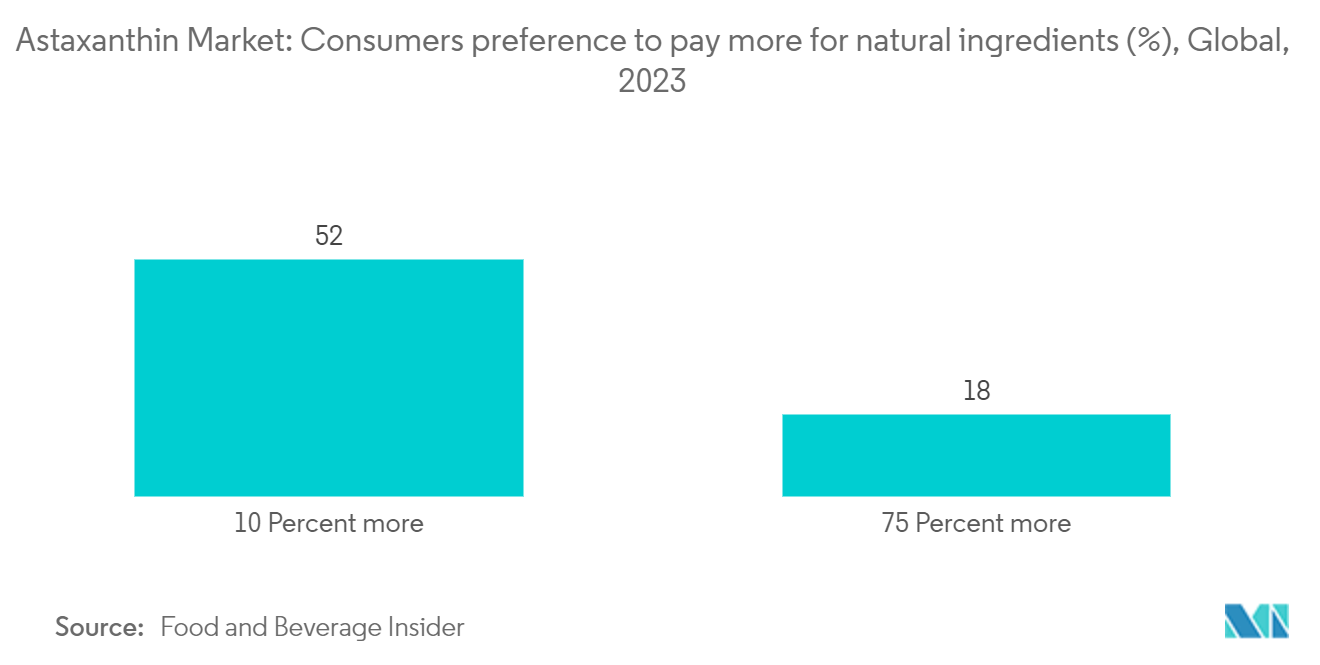
Asia-Pacific Holds a Significant Market Share
Asia-Pacific countries are providing enormous opportunities for astaxanthin players due to the presence of highly proactive consumers in the region with respect to personal wellness and a large aging population, leading to several opportunities for healthy aging ingredients and rapidly changing market conditions. Among Asia-Pacific countries, India and China are considered to be significant markets in terms of astaxanthin production due to their large population. Moreover, rapid urbanization, high consumer disposable income levels, and increasing awareness about natural products are anticipated to propel the market in this region. Various investments have been made by several global astaxanthin companies to increase their presence and reach in the region. For instance, Iceland-based astaxanthin ingredients and supplements producer Algalif (Reykjanesbaer) recently introduced its new IceCaps astaxanthin softness and its current Icelandic Harvest brand of finished astaxanthin dietary supplements in the Asia-Pacific countries.
Additionally, the popularity of dietary supplements is rising, and consumers are interested in supplements containing astaxanthin for its health benefits. Astaxanthin is a naturally occurring red carotenoid found in aquatic animals like salmon, trout, and shrimp. It is a powerful antioxidant that can help promote joint, skin, and eye health. Similarly, astaxanthin is also used as a feed additive in aquaculture to improve the quality of seafood. China is the world's largest producer of seafood, and Asia-Pacific as a whole has favorable climate conditions for algae cultivation, the primary source of astaxanthin production.
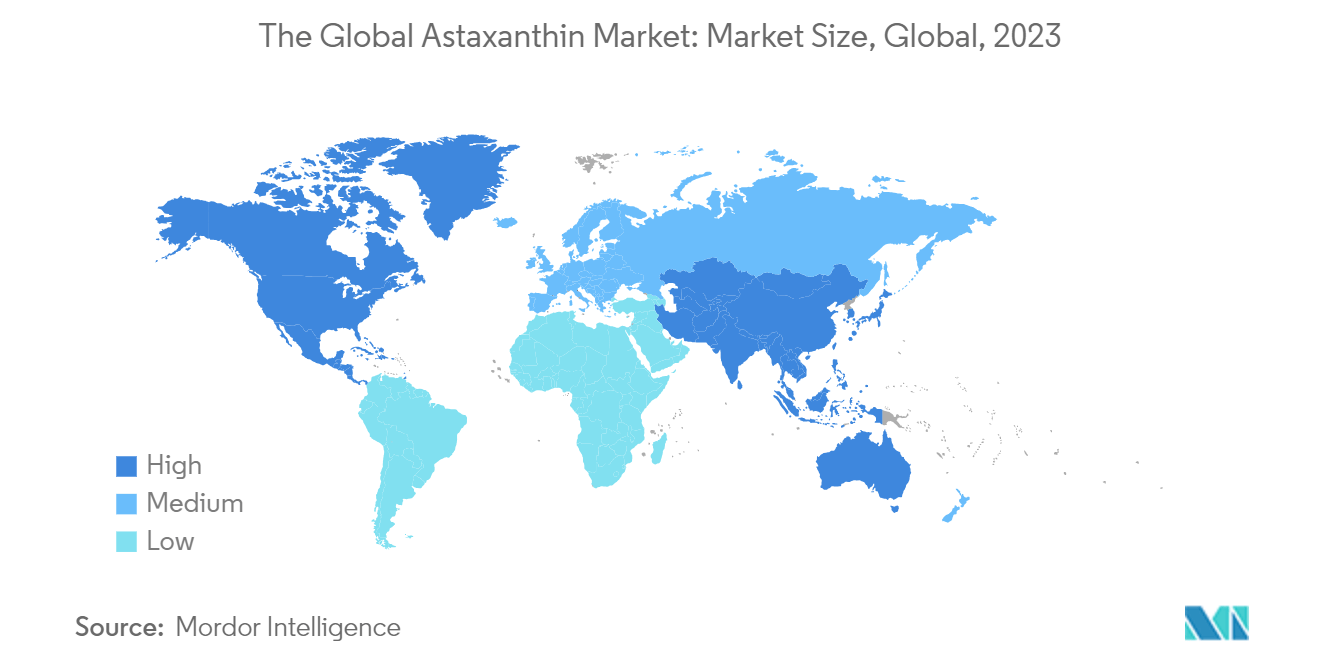
Astaxanthin Industry Overview
The global astaxanthin market has many players and is highly competitive. The market is dominated by global players; however, there is a significant presence of regional players. The key brands are embarking on expansions, mergers and acquisitions, and new product development as some of their key strategies, along with enhancing growth through investing, consolidating, and optimizing their offerings. For instance, in June 2023, a significant partnership emerged between a nutraceutical company and an aquaculture company, focusing on sourcing astaxanthin from responsibly farmed microalgae. This collaboration aims to establish a consistent and environmentally friendly supply chain for this valuable nutraceutical ingredient. Major players in the market are AstaReal Holdings Co. Ltd, KeyNatura, and BGG (Beijing Ginko Group), among others.
Astaxanthin Market Leaders
-
Cyanotech Corporation
-
Beijing Ginko Group
-
Koninklijke DSM N.V.
-
ENEOS Holdings, Inc.
-
BASF SE
*Disclaimer: Major Players sorted in no particular order
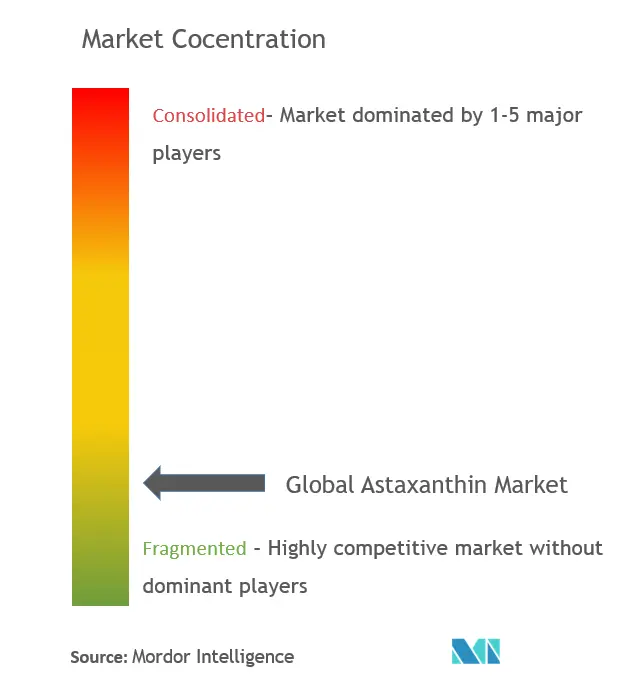
Astaxanthin Market News
- May 2024: US-based Divi's Nutraceuticals launched AstaBead, a product of sustainable natural astaxanthin beadlets, at Vitafoods 2024 in Switzerland. AstaBead is a collaboration between Divi’s and Algalif and uses Algalif's Iceland-based production process that uses 100% renewable energy.
- April 2024: US-based chemical vendor Alfa Chemistry announced the launch of a series of premium natural astaxanthin ingredients to improve health and well-being.
- February 2024: AstaReal, a Swedish astaxanthin company, announced that it had rebranded its Astaxin Original product and plans to launch a vegan version in Europe in the near future. AstaReal also gave nutraceutical companies a first look at the rebranded product at Fi Europe in Frankfurt at the end of 2023.
- April 2023: AstaReal partnered with i-ingredients, a distributor of specialty ingredients, to meet the growing demand for natural astaxanthin. i-ingredients also offers formulation, regulatory support, and contract manufacturing capabilities.
Astaxanthin Market Report - Table of Contents
1. INTRODUCTION
1.1 Study Assumptions and Market Definition
1.2 Scope of the Study
2. RESEARCH METHODOLOGY
3. EXECUTIVE SUMMARY
4. MARKET DYNAMICS
4.1 Market Drivers
4.1.1 Growing Demand for Natural Ingredients in Food and Cosmetics
4.1.2 Increasing Awareness of Health Benefits of Astaxanthin
4.2 Market Restraints
4.2.1 Limited Supply of Natural Astaxanthin Compared to Demand
4.3 Porter's Five Forces Analysis
4.3.1 Threat of New Entrants
4.3.2 Bargaining Power of Buyers/Consumers
4.3.3 Bargaining Power of Suppliers
4.3.4 Threat of Substitute Products
4.3.5 Intensity of Competitive Rivalry
5. MARKET SEGMENTATION
5.1 Type
5.1.1 Natural
5.1.2 Synthetic
5.2 Form
5.2.1 Liquid
5.2.2 Powder
5.3 Application
5.3.1 Food and Beverages
5.3.2 Dietary Supplements
5.3.3 Animal Feed
5.3.4 Cosmetics
5.3.5 Other Applications
5.4 Geography
5.4.1 North America
5.4.1.1 United States
5.4.1.2 Canada
5.4.1.3 Mexico
5.4.1.4 Rest of North America
5.4.2 Europe
5.4.2.1 Spain
5.4.2.2 United Kingdom
5.4.2.3 Germany
5.4.2.4 France
5.4.2.5 Italy
5.4.2.6 Russia
5.4.2.7 Rest of Europe
5.4.3 Asia-Pacific
5.4.3.1 China
5.4.3.2 Japan
5.4.3.3 India
5.4.3.4 Australia
5.4.3.5 Rest of Asia-Pacific
5.4.4 South America
5.4.4.1 Brazil
5.4.4.2 Argentina
5.4.4.3 Rest of South America
5.4.5 Middle East and Africa
5.4.5.1 South Africa
5.4.5.2 Saudi Arabia
5.4.5.3 Rest of Middle East and Africa
6. COMPETITIVE LANDSCAPE
6.1 Most Adopted Strategies
6.2 Market Share Analysis
6.3 Company Profiles
6.3.1 Beijing Ginko Group (BGG)
6.3.2 Fuji Chemical Industries Co. Ltd
6.3.3 Cyanotech Corporation
6.3.4 Koninklijke DSM NV
6.3.5 BASF SE
6.3.6 Divi's Laboratories Ltd.
6.3.7 ENEOS Holdings Inc.
6.3.8 Biogenic Co. Ltd
6.3.9 Otsuka Holdings Co. Ltd
6.3.10 Alga Technologies Ltd
- *List Not Exhaustive
7. MARKET OPPORTUNITIES AND FUTURE TRENDS
Astaxanthin Industry Segmentation
Astaxanthin is a blood-red pigment and is produced naturally in the freshwater microalgae Haematococcus pluvialis and the yeast fungus Xanthophyllomyces dendrorhous, among others. When algae are stressed by lack of nutrients, increased salinity, or excessive sunshine, it creates astaxanthin. The global astaxanthin market is segmented by type into natural and synthetic. By form, the market is segmented into liquid and power. By application, the market is segmented into food and beverage, dietary supplements, animal feed, cosmetics, and other applications. By geography, the market is segmented into North America, Europe, Asia-Pacific, South America, and Middle East and Africa. The market sizing has been done in value terms (USD) for all the abovementioned segments.
| Type | |
| Natural | |
| Synthetic |
| Form | |
| Liquid | |
| Powder |
| Application | |
| Food and Beverages | |
| Dietary Supplements | |
| Animal Feed | |
| Cosmetics | |
| Other Applications |
| Geography | |||||||||
| |||||||||
| |||||||||
| |||||||||
| |||||||||
|
Astaxanthin Market Research FAQs
How big is the Astaxanthin Market?
The Astaxanthin Market size is expected to reach USD 2.14 billion in 2024 and grow at a CAGR of 5.80% to reach USD 3.22 billion by 2029.
What is the current Astaxanthin Market size?
In 2024, the Astaxanthin Market size is expected to reach USD 2.14 billion.
Who are the key players in Astaxanthin Market?
Cyanotech Corporation, Beijing Ginko Group, Koninklijke DSM N.V., ENEOS Holdings, Inc. and BASF SE are the major companies operating in the Astaxanthin Market.
Which is the fastest growing region in Astaxanthin Market?
Asia-Pacific is estimated to grow at the highest CAGR over the forecast period (2024-2029).
Which region has the biggest share in Astaxanthin Market?
In 2024, the North America accounts for the largest market share in Astaxanthin Market.
What years does this Astaxanthin Market cover, and what was the market size in 2023?
In 2023, the Astaxanthin Market size was estimated at USD 2.02 billion. The report covers the Astaxanthin Market historical market size for years: 2019, 2020, 2021, 2022 and 2023. The report also forecasts the Astaxanthin Market size for years: 2024, 2025, 2026, 2027, 2028 and 2029.
Astaxanthin Industry Report
Statistics for the 2024 Astaxanthin market share, size and revenue growth rate, created by Mordor Intelligence™ Industry Reports. Astaxanthin analysis includes a market forecast outlook to 2029 and historical overview. Get a sample of this industry analysis as a free report PDF download.

